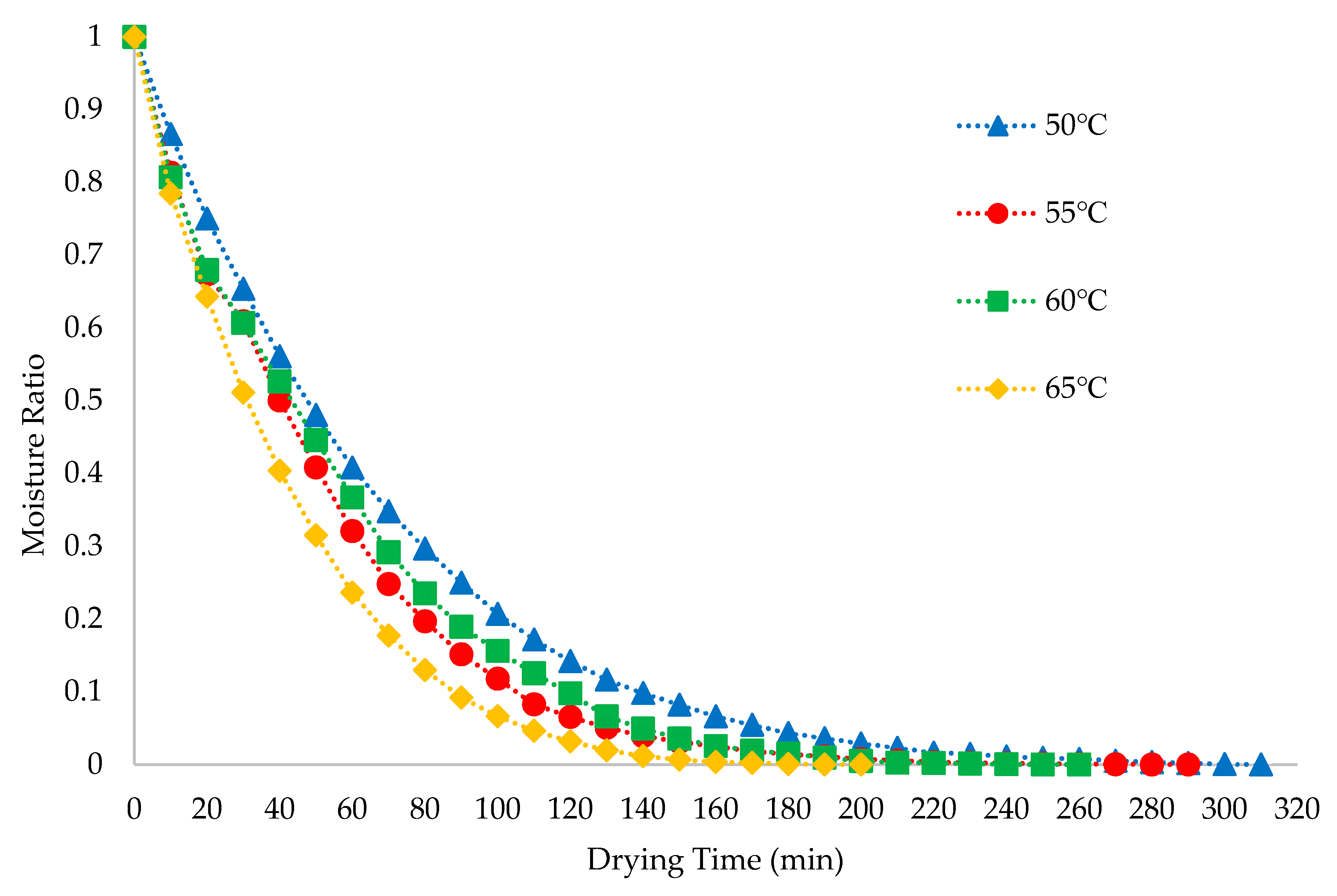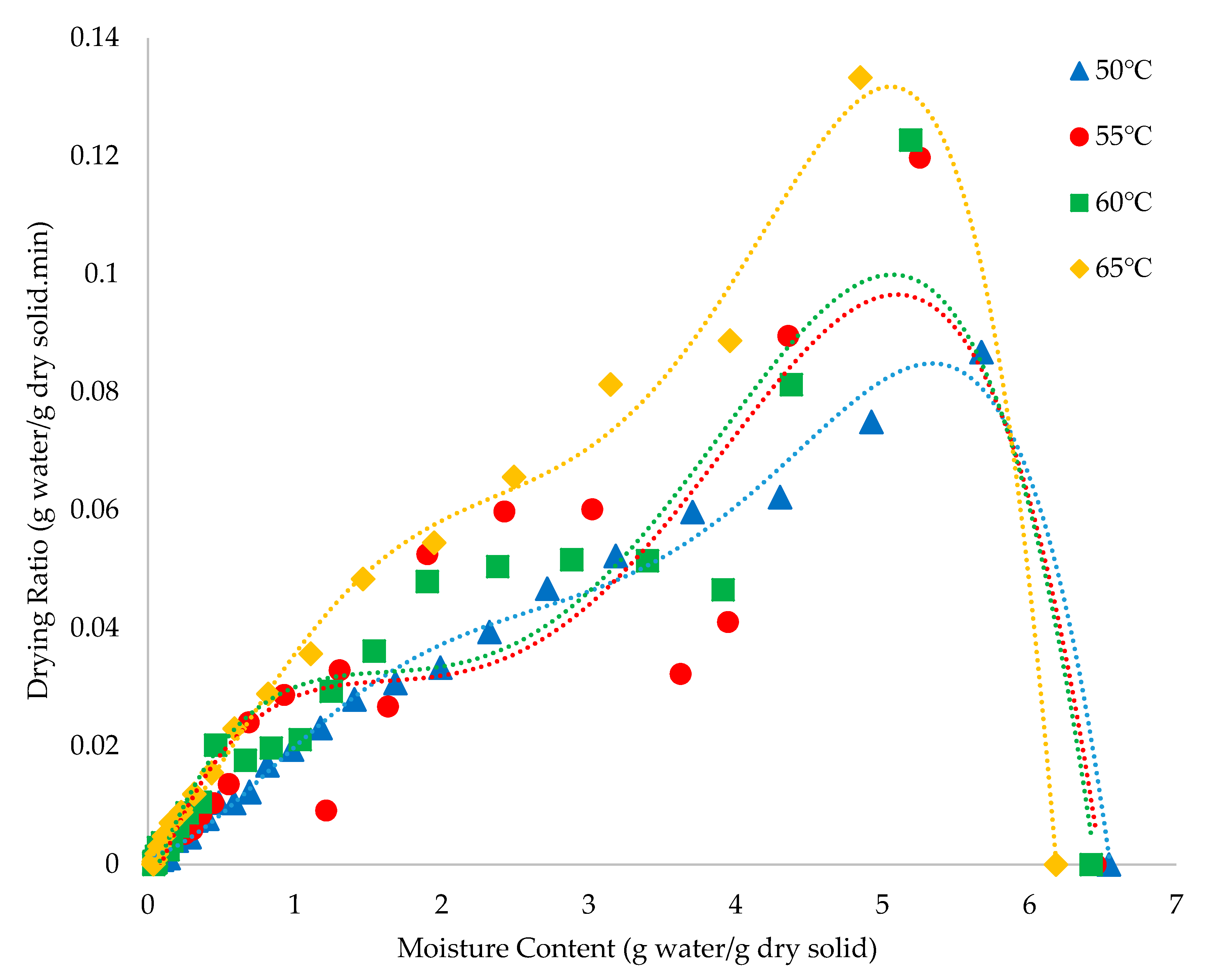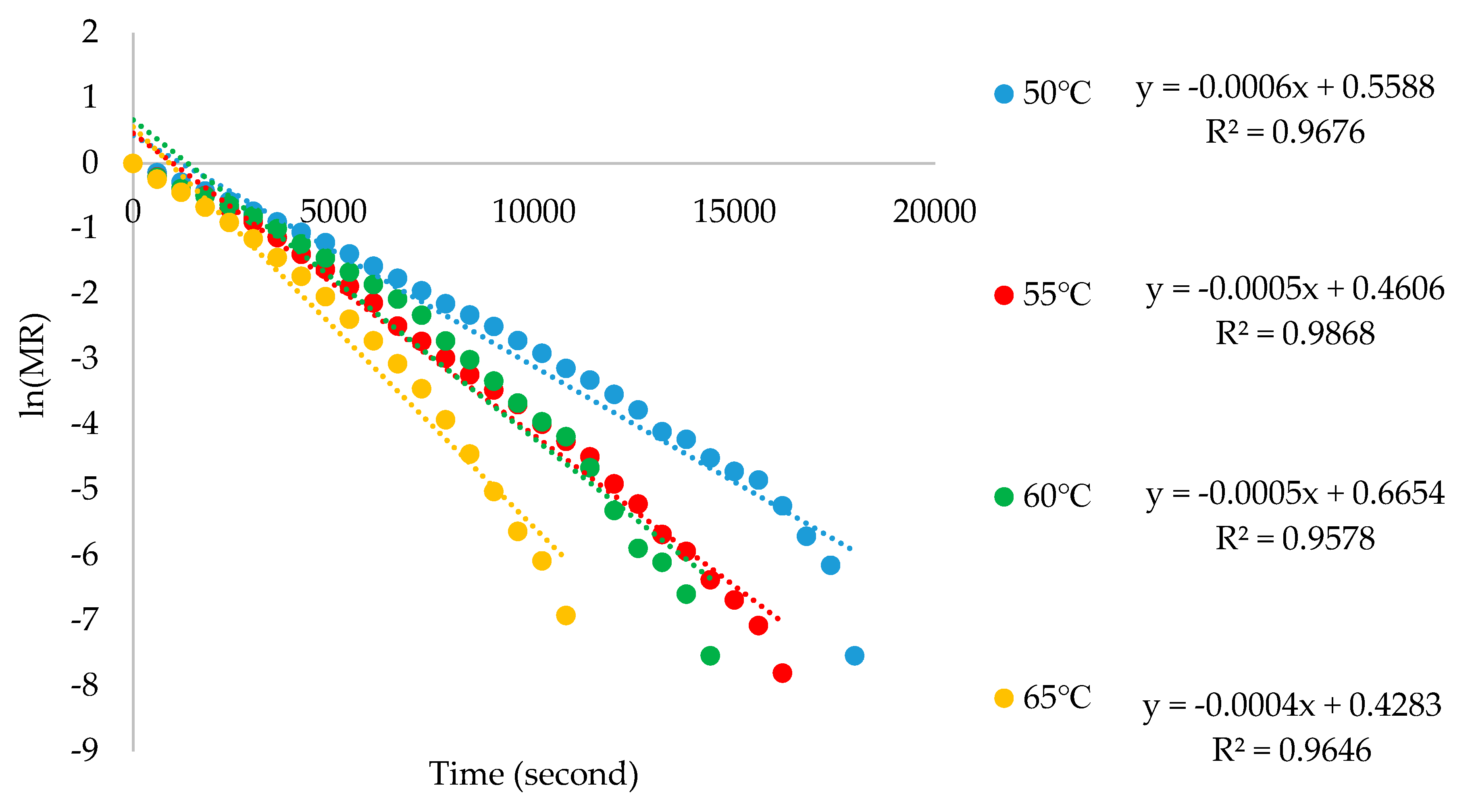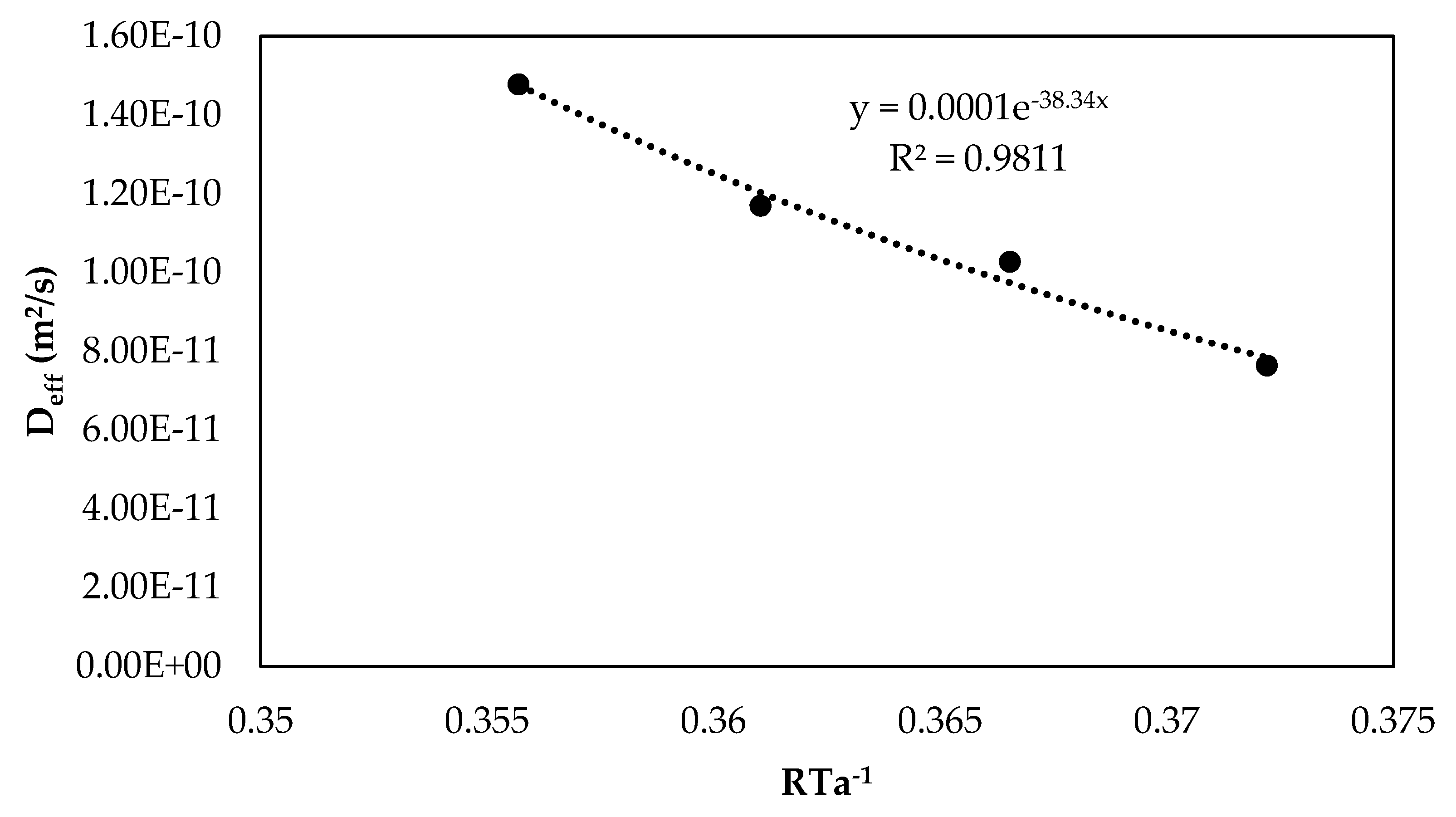Model for Thin Layer Drying of Lemongrass (Cymbopogon citratus) by Hot Air
Abstract
1. Introduction
2. Materials and Methods
2.1. Materials and Methods
2.1.1. Materials
2.1.2. Drying Equipment
2.1.3. Drying Procedure
2.2. Determination of Mathematical Components
2.2.1. Moisture Content
2.2.2. Drying Rate
2.2.3. Mathematical Modeling of Drying Curves
2.2.4. Estimation of the Effective Moisture Diffusivity
2.2.5. Estimation of Activation Energy
2.2.6. Data Analysis
3. Results
3.1. Drying Curves and Drying Rate Curves
3.2. Mathematical Models of Drying Curves
3.3. Estimation of the Effective Moisture Diffusivity
3.4. Estimation of Activation Energy
4. Conclusions
Author Contributions
Funding
Acknowledgments
Conflicts of Interest
References
- Skaria, B.P.; Joy, P.P.; Mathew, S.; Mathew, G. Lemongrass. In Handbook of Herbs and Spices, 3rd ed.; Peter, K.V., Ed.; Woodhead Publishing Limited: Cambridge, UK, 2006; pp. 400–419. [Google Scholar]
- Lindenmuth, G.F.; Lindenmuth, E.B. The Efficacy of Echinacea Compound Herbal Tea Preparation on the Severity and Duration of Upper Respiratory and Flu Symptoms: A Randomized, Double-Blind Placebo-Controlled Study. J. Altern. Complement. Med. 2000, 6, 327–334. [Google Scholar] [CrossRef] [PubMed]
- Haque, A.N.M.A.; Remadevi, R.; Naebe, M. Lemongrass (Cymbopogon): A review on its structure, properties, applications and recent developments. Cellulose 2018, 25, 5455–5477. [Google Scholar] [CrossRef]
- Ekpenyong, C.E.; Akpan, E.; Nyoh, A. Ethnopharmacology, phytochemistry, and biological activities of Cymbopogon citratus (DC.) Stapf extracts. Chin. J. Nat. Med. 2015, 13, 321–337. [Google Scholar] [CrossRef]
- Barbosa, L.; Pereira, U.; Martinazzo, A.; Maltha, C.; Teixeira, R.; Melo, E. Evaluation of the Chemical Composition of Brazilian Commercial Cymbopogon citratus (D.C.) Stapf Samples. Molecules 2008, 13, 1864–1874. [Google Scholar] [CrossRef] [PubMed]
- Olorunnisola, S.K.; Hammed, A.M.; Simsek, S. Biological properties of lemongrass: An overview. Int. Food Res. J. 2014, 21, 455–462. [Google Scholar]
- Korenblum, E.; Regina de Vasconcelos Goulart, F.; de Almeida Rodrigues, I.; Abreu, F.; Lins, U.; Alves, P.; Blank, A.; Valoni, É.; Sebastián, G.V.; Alviano, D.; et al. Antimicrobial action and anti-corrosion effect against sulfate reducing bacteria by lemongrass (Cymbopogon citratus) essential oil and its major component, the citral. AMB Express 2013, 3, 44. [Google Scholar] [CrossRef] [PubMed]
- Nguyen, H.; Campi, E.M.; Roy Jackson, W.; Patti, A.F. Effect of oxidative deterioration on flavour and aroma components of lemon oil. Food Chem. 2009, 112, 388–393. [Google Scholar] [CrossRef]
- Aguilera, J.M.; Stanley, D.W. Microstructural Principles of Food Processing and Engineering, 2nd ed.; Aspen Publishers: Gaithersburg, MD, USA, 1999; ISBN 9780834212565. [Google Scholar]
- Doymaz, İ. Drying Kinetics and Rehydration Characteristics of Convective Hot-Air Dried White Button Mushroom Slices. J. Chem. 2014, 2014, 1–8. [Google Scholar] [CrossRef]
- Coradi, P.C.; de Melo, E.C.; da Rocha, R.P. Evaluation of Electrical Conductivity as a Quality Parameter of Lemongrass Leaves (Cymbopogon citratus Stapf) Submitted to Drying Process. Dry. Technol. 2014, 32, 969–980. [Google Scholar] [CrossRef]
- Simha, P.; Mathew, M.; Ganesapillai, M. Empirical modeling of drying kinetics and microwave assisted extraction of bioactive compounds from Adathoda vasica and Cymbopogon citratus. Alex. Eng. J. 2016, 55, 141–150. [Google Scholar] [CrossRef]
- Association of Official Analytical Chemists. Official Methods of Analysis; AOAC: Washington, DC, USA, 1999. [Google Scholar]
- Rocha, R.P. Influence of drying process on the quality of medicinal plants: A review. J. Med. Plants Res. 2011, 5, 7076–7084. [Google Scholar] [CrossRef]
- Mohamed Hanaa, A.R.; Sallam, Y.I.; El-Leithy, A.S.; Aly, S.E. Lemongrass (Cymbopogon citratus) essential oil as affected by drying methods. Ann. Agric. Sci. 2012, 57, 113–116. [Google Scholar] [CrossRef]
- Buggle, V.; Ming, L.C.; Furtado, E.L.; Rocha, S.F.R. Influence of Different Drying Temperatures on the Amount of Essential Oils and Citral Content in Cymbopogon citratus (DC) Stapf.-Poaceae. Acta Hortic. 1999, 5, 71–74. [Google Scholar] [CrossRef]
- Buchaillot, A.; Caffin, N.; Bhandari, B. Drying of Lemon Myrtle (Backhousia citriodora) Leaves: Retention of Volatiles and Color. Dry. Technol. 2009, 27, 445–450. [Google Scholar] [CrossRef]
- Rocha, R.P.; Ming, L.C.; Marques, M.O.M. Influence of five drying temperatures on the yield and composition of essential oil of citronella (Cymbopogon winterianus Jowitt). J. Med. Plants 2000, 3, 73–78. [Google Scholar]
- Velić, D.; Planinić, M.; Tomas, S.; Bilić, M. Influence of airflow velocity on kinetics of convection apple drying. J. Food Eng. 2004, 64, 97–102. [Google Scholar] [CrossRef]
- Akpinar, E.; Midilli, A.; Bicer, Y. Single layer drying behaviour of potato slices in a convective cyclone dryer and mathematical modeling. Energy Convers. Manag. 2003, 44, 1689–1705. [Google Scholar] [CrossRef]
- Toğrul, H. Suitable drying model for infrared drying of carrot. J. Food Eng. 2006, 77, 610–619. [Google Scholar] [CrossRef]
- Crank, J. The Mathematics of Diffusion, Oxford Science Publications, 2nd ed.; Oxford University Press: Oxford, UK, 2009; ISBN 9780198534112. [Google Scholar]
- Lopez, A.; Iguaz, A.; Esnoz, A.; Virseda, P. Modelling of sorption isotherms of dried vegetable wastes from wholesale market. Dry. Technol. 2000, 18, 985–994. [Google Scholar] [CrossRef]
- Chong, C.H.; Law, C.L.; Cloke, M.; Hii, C.L.; Abdullah, L.C.; Daud, W.R.W. Drying kinetics and product quality of dried Chempedak. J. Food Eng. 2008, 88, 522–527. [Google Scholar] [CrossRef]
- Onwude, D.I.; Hashim, N.; Janius, R.B.; Nawi, N.M.; Abdan, K. Modeling the Thin-Layer Drying of Fruits and Vegetables: A Review: Thin-layer models of fruits and vegetables. Compr. Rev. Food Sci. Food Saf. 2016, 15, 599–618. [Google Scholar] [CrossRef]
- Ibrahim, M.; Sopian, K.; Daud, W.R.W. Study of the Drying Kinetics of Lemongrass. Am. J. Appl. Sci. 2009, 6, 1070–1075. [Google Scholar] [CrossRef]






| No | Model | Equations |
|---|---|---|
| 1 | Page | |
| 2 | Henderson and Pabis | |
| 3 | Midilli | |
| 4 | Logarithmic | |
| 5 | Two-term | |
| 6 | Wang and Singh | |
| 7 | Weibull |
| Temp. | Model | Coefficients | Statistics | |||||
|---|---|---|---|---|---|---|---|---|
| R2 | RMSE | x2 | ||||||
| 50 °C | Page | k = 0.00011 | n = 1.10025 | 0.99959 | 0.00557 | 3.30 × 10−5 | ||
| 55 °C | k = 0.00015 | n = 1.07613 | 0.99505 | 0.01912 | 3.92 × 10−4 | |||
| 60 °C | k = 0.00014 | n = 1.09420 | 0.99555 | 0.01861 | 3.74 × 10−4 | |||
| 65 °C | k = 0.00017 | n = 1.10771 | 0.99865 | 0.01048 | 1.21 × 10−4 | |||
| 50 °C | Henderson and Pabis | a = 1.02592 | k = 0.00026 | 0.99790 | 0.01266 | 1.71 × 10−4 | ||
| 55 °C | a = 1.00482 | k = 0.00029 | 0.99377 | 0.02147 | 4.94 × 10−4 | |||
| 60 °C | a = 1.00910 | k = 0.00031 | 0.99361 | 0.02229 | 5.36 × 10−4 | |||
| 65 °C | a = 1.01880 | k = 0.00042 | 0.99661 | 0.01660 | 3.05 × 10−4 | |||
| 50 °C | Midilli | a = 0.99120 | k = 0.00011 | n = 1.09672 | b = −4.12 × 10−7 | 0.99980 | 0.00386 | 1.65 × 10−5 |
| 55 °C | a = 0.96973 | k = 0.00012 | n = 1.09701 | b = −6.75 × 10−7 | 0.99607 | 0.01703 | 3.22 × 10−4 | |
| 60 °C | a = 0.97110 | k = 0.00012 | n = 1.09938 | b = −1.19 × 10−6 | 0.99704 | 0.01516 | 2.59 × 10−4 | |
| 65 °C | a = 0.98882 | k = 0.00018 | n = 1.09637 | b = −1.07 × 10−6 | 0.99917 | 0.00821 | 7.86 × 10−5 | |
| 50 °C | Logarithm | a = 1.03448 | k = 0.00025 | c = −0.01985 | 0.99923 | 0.00769 | 6.52 × 10−5 | |
| 55 °C | a = 1.01527 | k = 0.00027 | c = −0.02295 | 0.99574 | 0.01775 | 3.50 × 10−4 | ||
| 60 °C | a = 1.02510 | k = 0.00028 | c = −0.03240 | 0.99682 | 0.01573 | 2.70 × 10−4 | ||
| 65 °C | a = 1.03218 | k = 0.00038 | c = −0.02517 | 0.99870 | 0.01027 | 1.23 × 10−4 | ||
| 50 °C | Two-term | a = 0.50040 | k1 = 0.00026 | b = 0.49978 | k2 = 0.00026 | 0.99730 | 0.01435 | 2.35 × 10−4 |
| 55 °C | a = 0.55424 | k1 = 0.00029 | b = 0.44483 | k2 = 0.00029 | 0.99373 | 0.02152 | 5.34 × 10−4 | |
| 60 °C | a = 0.50114 | k1 = 0.00030 | b = 0.50058 | k2 = 0.00031 | 0.99356 | 0.02238 | 5.88 × 10−4 | |
| 65 °C | a = 0.49822 | k1 = 0.00041 | b = 0.50202 | k2 = 0.00041 | 0.99628 | 0.01740 | 3.74 × 10−4 | |
| 50 °C | Wang and Singh | a = −0.00016 | b = 0.00000 | 0.94964 | 0.06197 | 4.10 × 10−3 | ||
| 55 °C | a = −0.00017 | b = 0.00000 | 0.93582 | 0.06887 | 5.08 × 10−3 | |||
| 60 °C | a = −0.00019 | b = 0.00000 | 0.95715 | 0.05773 | 3.60 × 10−3 | |||
| 65 °C | a = −0.00025 | b = 0.00000 | 0.95231 | 0.06229 | 4.29 × 10−3 | |||
| 50 °C | Weibull | a = −0.00803 | b = −1.00008 | k0 = 0.000117 | n = 1.08916 | 0.99983 | 0.00362 | 1.50 × 10−5 |
| 55 °C | a = −0.01311 | b = −0.98494 | k0 = 0.000138 | n = 1.08109 | 0.99620 | 0.01676 | 3.24 × 10−4 | |
| 60 °C | a = −0.02076 | b = −0.99429 | k0 = 0.000143 | n = 1.07915 | 0.99725 | 0.01463 | 2.51 × 10−4 | |
| 65 °C | a = −0.01382 | b = −1.00375 | k0 = 0.000199 | n = 1.08323 | 0.99927 | 0.00772 | 7.37 × 10−5 | |
| Temperature | Slope | Deff (m/s2) |
|---|---|---|
| 50 °C | −0.000353784 | 7.64 × 10−11 |
| 55 °C | −0.000475707 | 1.03 × 10−10 |
| 60 °C | −0.000541341 | 1.17 × 10−10 |
| 65 °C | −0.000684259 | 1.48 × 10−10 |
© 2019 by the authors. Licensee MDPI, Basel, Switzerland. This article is an open access article distributed under the terms and conditions of the Creative Commons Attribution (CC BY) license (http://creativecommons.org/licenses/by/4.0/).
Share and Cite
Nguyen, T.V.L.; Nguyen, M.D.; Nguyen, D.C.; Bach, L.G.; Lam, T.D. Model for Thin Layer Drying of Lemongrass (Cymbopogon citratus) by Hot Air. Processes 2019, 7, 21. https://doi.org/10.3390/pr7010021
Nguyen TVL, Nguyen MD, Nguyen DC, Bach LG, Lam TD. Model for Thin Layer Drying of Lemongrass (Cymbopogon citratus) by Hot Air. Processes. 2019; 7(1):21. https://doi.org/10.3390/pr7010021
Chicago/Turabian StyleNguyen, Thi Van Linh, My Duyen Nguyen, Duy Chinh Nguyen, Long Giang Bach, and Tri Duc Lam. 2019. "Model for Thin Layer Drying of Lemongrass (Cymbopogon citratus) by Hot Air" Processes 7, no. 1: 21. https://doi.org/10.3390/pr7010021
APA StyleNguyen, T. V. L., Nguyen, M. D., Nguyen, D. C., Bach, L. G., & Lam, T. D. (2019). Model for Thin Layer Drying of Lemongrass (Cymbopogon citratus) by Hot Air. Processes, 7(1), 21. https://doi.org/10.3390/pr7010021





